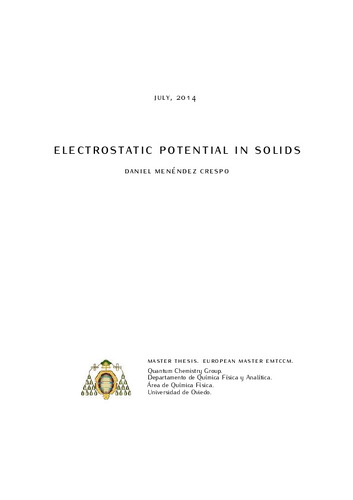Electrostatic potential in solids
Otros títulos:
Potencial electrostático en sólidos
Autor(es) y otros:
Director(es):
Palabra(s) clave:
Electrostátic potential
Quantum Chemical Topology
Hansen-Coppens
BTDMTTF-TCNQ
Charge-transfer
Fecha de publicación:
Serie:
Máster Universitario en Química Teórica y Modelización Computacional
Descripción física:
Resumen:
The organic conductor BTDMTTF-TCNQ (C10H8S+ · C12H4N− ) is a charge-transfer complex that behaves as an almost pure 1D metal, showing metallic character down to 26 K. The magnitude of the intermolecular charge transfer at T = 130 K was initially estimated at approximately 0.7 e from the values of the multipolar parameters obtained in an experimental charge density study. Recently, a QTAIM analysis applied to the same multipolar charge density model revealed more accurate atomic charges. Indeed, while charges inferred from multipoles replicate integrated charges for coarse grained atomic groups, they fail when fine granularity (e.g. C, N) is demanded. In addition, contributions to charge transfer are spread amongst several atoms instead of being localized in sulfur atoms, as previously pointed out. Also, we have systematically identified the interactions present in the crystal phase using the topology of the electrostatic potential, and the Laplacian of the electron density with the MoPro and critic2 programs.
The organic conductor BTDMTTF-TCNQ (C10H8S+ · C12H4N− ) is a charge-transfer complex that behaves as an almost pure 1D metal, showing metallic character down to 26 K. The magnitude of the intermolecular charge transfer at T = 130 K was initially estimated at approximately 0.7 e from the values of the multipolar parameters obtained in an experimental charge density study. Recently, a QTAIM analysis applied to the same multipolar charge density model revealed more accurate atomic charges. Indeed, while charges inferred from multipoles replicate integrated charges for coarse grained atomic groups, they fail when fine granularity (e.g. C, N) is demanded. In addition, contributions to charge transfer are spread amongst several atoms instead of being localized in sulfur atoms, as previously pointed out. Also, we have systematically identified the interactions present in the crystal phase using the topology of the electrostatic potential, and the Laplacian of the electron density with the MoPro and critic2 programs.
Colecciones
- Trabajos Fin de Máster [5296]
Ficheros en el ítem





